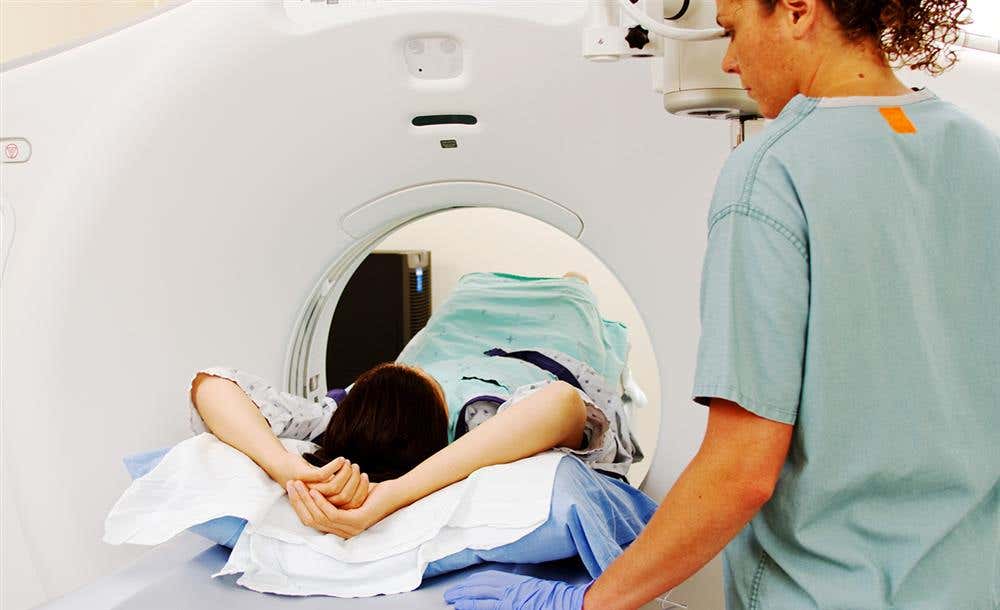Virtual lung cancer screening is just as effective as in-person screening
Virtual single-visit lung cancer screenings are just as effective as single-visit screenings done in person at the hospital.

[Oct 24, 2021: American College of Surgeons]
Virtual single-visit screenings are just as effective as single-visit screenings done in person at the hospital. (Credit: Creative Commons)
A novel telemedicine lung cancer screening effort during the COVID-19 pandemic shows that virtual single-visit screenings are just as effective as single-visit screenings done in person at the hospital, according to a study presented at the American College of Surgeons (ACS) Virtual Clinical Congress 2021.
The study of virtual lung cancer screenings (LCS) was performed at Temple University Hospital, Philadelphia, which has a large African American patient population. African Americans face disparities in care, especially for lung cancer. They are less likely to be screened and treated for lung cancer and more likely to die from it, compared with the general population, explained Jessica S. Magarinos, MD, a general surgery resident at Temple University Hospital and first author of the study. Although the authors hypothesized that LCS disparities would be exacerbated during COVID-19, this was not the case, she said.
“Our study shows that telemedicine screenings were able to reach the African American population in a safety net hospital,” Dr. Magarinos reported.
Implementation of a Novel, Single-Encounter Telemedicine Lung Cancer Screening (SET-LCS) During Covid-19 Preserves Access among African Americans. (Credit: American College of Surgeons)
More people need to be screened for lung cancer
More people die of lung cancer every year than from any other type of cancer. Although lung cancer can be successfully treated if caught early enough, only about 3-to-6 percent of the population eligible for LCS get screened, said Cherie P. Erkmen, MD, FACS, a thoracic surgeon at Temple University Hospital and the principal investigator for the retrospective study.
“Overall, we do a sorrowful job of getting people to undergo lung cancer screening,” Dr. Erkmen said. “We can reduce preventable lung cancer death by finding novel ways of getting people screened.”
Related Stories
With the advent of COVID-19 pandemic, many patients—acting on advice from such scientific advisory groups such as the American College of Chest Physicians (CHEST)—decided to defer getting screened for lung cancer. The authors at Temple University in Philadelphia decided to quickly pivot to offer telemedicine lung cancer screenings, which mitigates the risk of exposure to the COVID-19 virus. Earlier this year, the ACS was one of the major health care organizations that issued a call for patients to not miss cancer screenings due to COVID-19.
Study details
The researchers compared 673 patients who received single-visit lung cancer screening (LCS) patients before the COVID-19 pandemic with 440 patients who received Single Encounter Telemedicine Lung Cancer Screening (SET-LCS) since March of 2020, when the pandemic began to prompt shutdowns across the U.S.
For the LCS population, the authors retrospectively analyzed prospectively collected data from February 2021 and earlier; for both groups, they looked at race, smoking history, educational status, Lung-RADS®*, cancer diagnosis and stage, and adherence to follow-up using the Chi-square test and Fisher’s exact test.
Study findings
The distribution of patient race before and after COVID-19 was not significantly different; in each case, the largest group of screened patients was African American (52 percent before, 37 percent after), Dr. Magarinos said. Smoking history was significantly different; 65 percent of those undergoing screening before COVID-19 were active smokers compared with 33 percent after COVID-19.
The authors concluded there was no significant difference in the distribution of Lung-RADs results (single visit vs. telemedicine):
Lung-RADS1, 46.4 percent vs. 37.0 percent
Lung-RADS2, 44.0 percent vs. 50.8 percent
Lung-RADS3, 5.3 percent vs. 7.6 percent
Lung-RADS4, 4.2 percent vs. 4.8 percent
Lung-RADS0, 0.1 percent vs. 0.2 percent
The authors also concluded there was no significant difference in the frequency of procedures for cancer diagnoses
CT guided biopsy, 0.4 percent vs. 0.5 percent
EBUS guided biopsy, 0.3 percent vs. 0.5 percent
Surgery 2.5 percent vs. 1.1 percent
Declined diagnostic work up, 0.3 percent vs. 0.2 percent
Deceased prior to diagnostic work up, 0 percent vs. 0.2 percent
These multiple findings led the researchers to conclude that telemedicine screening was just as effective as in-person screenings.
Although the telemedicine approach allowed many patients to get screened for lung cancer, overall the number of people who were screened for lung cancer during the pandemic declined by 75 percent, according to the authors.
Dr. Erkmen hopes continued telemedicine lung cancer screenings after the pandemic will eliminate some barriers to getting screened and will result in more people getting screened.
The authors believe that telemedicine screening is applicable to other types of cancers, including breast cancer or colorectal cancer screening, said Dr. Magarinos.
For more science and technology stories check out our New Discoveries section at The Brighter Side of News.
Like these kind of feel good stories? Get the Brighter Side of News' newsletter.
Tags: #New_Discoveries, #Lung_Cancer, #Telehealth, #Doctors, #Health_News, #Medical_Good_News, #The_Brighter_Side_of_News
Joshua Shavit
Science & Technology Writer | AI and Robotics Reporter
Joshua Shavit is a Los Angeles-based science and technology writer with a passion for exploring the breakthroughs shaping the future. As a contributor to The Brighter Side of News, he focuses on positive and transformative advancements in AI, technology, physics, engineering, robotics and space science. Joshua is currently working towards a Bachelor of Science in Business Administration at the University of California, Berkeley. He combines his academic background with a talent for storytelling, making complex scientific discoveries engaging and accessible. His work highlights the innovators behind the ideas, bringing readers closer to the people driving progress.



